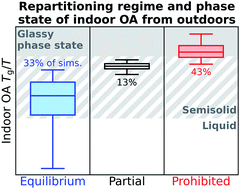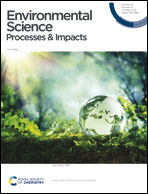Phase state of organic aerosols may limit temperature-driven thermodynamic repartitioning following outdoor-to-indoor transport†
Abstract
Ambient aerosols often experience temperature and humidity gradients following outdoor-to-indoor transport, causing organic aerosols (OA) to either gain or lose mass via gas-particle repartitioning. Recent models have sought to quantify these effects using equilibrium partitioning thermodynamics. However, evidence suggests some indoor OA may possess glassy or semisolid phase states with higher viscosities than liquid OA. Characteristic partitioning timescales of higher-viscosity particles are significantly longer than for liquid particles, which may either fully or partially inhibit repartitioning. For outdoor OA experiencing a temperature change during transport indoors, the ultimate repartitioning state depends on the relationship between the gas-particle partitioning rate coefficient (kgp) of semivolatile organics and the indoor particle loss rate coefficient (lp). That is, thermodynamic equilibrium partitioning may occur when semivolatile kgp ≫ lp, no repartitioning when semivolatile kgp ≪ lp, and partial repartitioning when their magnitudes are similar. Longer indoor particle lifetimes, higher particle number, and larger particle sizes all raise kgp (driving repartitioning towards equilibrium). For simulated U.S. residences, equilibrium condensation was likely reached in humid climate zones during warm meteorological conditions. In colder regions, the degree of evaporative repartitioning depended on whether organics could repartition before the particle phase state adjusts to indoor conditions, which is uncertain. When an appreciable temperature gradient exists, this study not only confirmed that all outdoor-originating OA that is liquid indoors will reach thermodynamic equilibrium, but also concluded that a plurality (46% for this domain) of such OA that is semisolid may also achieve thermodynamic equilibrium during its indoor lifetime.

- This article is part of the themed collection: Atmospheric chemistry


 Please wait while we load your content...
Please wait while we load your content...